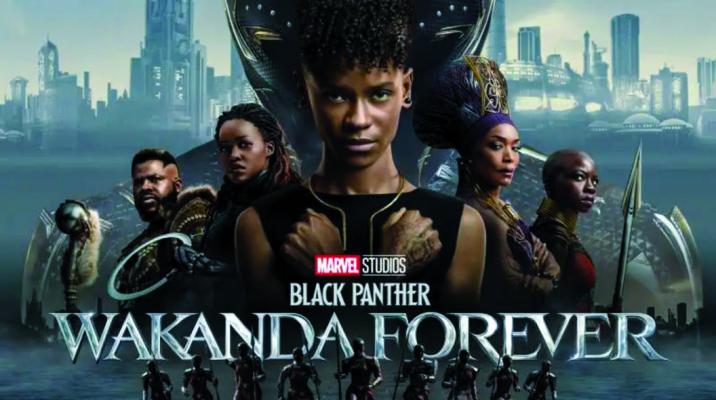Black Panther: Wakanda Forever
Comically Serious
Non-spoiler review
One of the first columns I wrote while here at the newspaper was about the passing of Chadwick Boseman. Boseman was 43 when he passed away on Aug. 28, 2020 and it is an understatement to say that his death took the entire world by surprise.
Boseman kept his illness private the whole time he was making movies, getting into superhero shape for roles and visiting sick children in hospitals who were fighting their own battles with cancer.
He left behind an impressive body of work. His roles in front of and behind the camera helped to amplify Black voices in media.
Needless to say, Boseman’s passing resulted in massive changes to what this film would’ve ultimately entailed. Now, it served not only as a sequel to one of Marvel’s most successful films, but it also needed to pay tribute to Boseman as well.
The film begins with a cold open, King T’Challa is dying from a disease that his sister Shuri (Letitia Wright) believes she can cure with a heartshaped herb. However, since Erik Killmonger burned all the plants in the previous movie, she attempts to make a synthetic herb, but this results in failure and the king passes.
A year later, Wakanda is under pressure from other countries to share their vibranium, with some even going so far as to attack Wakandan outreach centers to obtain the precious metal.
One of these operations by the CIA uses a device made by an American scientist to detect vibranium and discovers a deposit underwater. However, this isn’t all they discover, as they come into contact with Namor (Tenoch Huerta Mejía) and his blue-skinned, water breathing people of Talokan.
Namor goes to Shuri and Queen Ramonda (Angela Bassett), blaming Wakanda for the vibranium race that threatens his people. Namor gives Wakanda an ultimatum: give him the scientist responsible for the vibranium- detecting machine or he will attack Wakanda.
This film had a lot of heavy lifting to do following the success of the first movie and in dealing with the passing of its star. As such, this film became an ensemble without a true main character so to speak. That being said, Letitia Wright’s Shuri gets the most focus, as it is her grief and the ways she processes the death of her brother that make up the dramatic through line of the movie.
The rest of the supporting cast from the first Black Panther movie return and show the various ways they deal with the loss of T’Challa and their place in the world now. Most notably is Angela Bassett, who delivers a strong performance showing a woman that treads the line between grief and rage while also being a strong leader for her people.
This movie introduces the character of Riri Williams/Ironheart played by Dominique Thorne. Riri, much like Shuri, is a prodigy and has a knack for invention. She serves as something of a foil to Shuri, with Riri’s similarities and differences helping to shape Shuri’s arc of maturity.
As seen in the trailer, Riri does don an Iron Man-style mech suit, although it more resembles some anime mech suits than Stark’s suit ever did (think something like Bubblegum Crisis).
But I think the highlight of the movie is Tenoch Huerta Mejía as Namor.
Namor (along with the Jim Hammond Human Torch) is one of Marvel’s first big characters, debuting in 1939. Namor was presented in the comics as the son of an American sea captain and an Atlantean woman, possessing the abilities of both species as well as his own unique mutant (yes, as in X-Men mutant) abilities to fly via wings on his ankles.
Now if that origin sounds like Aquaman, well that’s because it is very similar, although it should be noted that Namor debuted in the comics before Aquaman. However, since DCEU’s Aquaman came out four years before this movie, it was necessary to change the origins of Namor and his people.
They now have Mesoamerican origins, particularly those of the Maya people.
Namor steals every scene he is in, and the film has some incredibly imaginative uses of his abilities.
Unfortunately, the movie is not without its flaws, and the third act presents some iffy CGI and well as equally iffy tactical decisions for the final battle (choosing to fight a bunch of people adapted to the water out at sea seems like a poor choice).
I also found the music to not be as memorable as the first movie.
With this movie wrapped up, we finally reach the end of the MCU’s Phase 4, a phase that has felt somewhat directionless and disjointed, but that will be the topic of another column.
Black Panther: Wakanda Forever is a movie that had a lot of things stacked against it and showcased that even the best laid plans of something like even the MCU can be undone by tragic reallife events, and not just Boseman’s passing, but the COVID-19 pandemic as well.
Despite elements working against it, Black Panther: Wakanda Forever is a solid film that serves as a farewell to not only the character of T’Challa, but to the man that brought the character to life and made him an global icon.
Black Panther: Wakanda Forever gets an 8/10.


